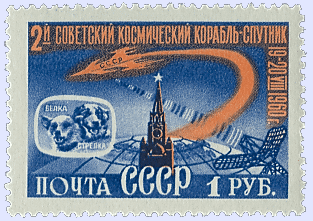Sputnik 5 on:
[Wikipedia]
[Google]
[Amazon]
 Korabl-Sputnik 2 (russian: Корабль-Спутник 2, lit=Ship-Satellite 2), also known as Sputnik 5 in the West, was a Soviet artificial satellite, and the third test flight of the Vostok spacecraft. It was the first spaceflight to send animals into orbit and return them safely back to Earth, including two Soviet space dogs, Belka and Strelka. Launched on 19 August 1960, it paved the way for the first human orbital flight, Vostok 1, which was launched less than eight months later.
Korabl-Sputnik 2 (russian: Корабль-Спутник 2, lit=Ship-Satellite 2), also known as Sputnik 5 in the West, was a Soviet artificial satellite, and the third test flight of the Vostok spacecraft. It was the first spaceflight to send animals into orbit and return them safely back to Earth, including two Soviet space dogs, Belka and Strelka. Launched on 19 August 1960, it paved the way for the first human orbital flight, Vostok 1, which was launched less than eight months later.
Background
Korabl-Sputnik 2 was the second attempt to launch a Vostok capsule with dogs on board. The first try on 28 July, carrying a pair named Bars (Snow Leopard aka Chaika (Seagull)) and Lisichka (Foxie), had been unsuccessful after the Blok G strap-on suffered a fire and breakdown in one of the combustion chambers, followed by its breaking off of the booster 19 seconds after launch. Around 30 seconds, the launch vehicle disintegrated, the core and strap-ons flying in random directions and crashing into the steppe. Flight controllers sent a command to jettison the payload shroud and separate the descent module, but due to the low altitude, the parachutes only deployed partially, and the dogs were killed on impact with the ground. The Blok G engine failure was traced to high frequency pressure oscillations in the RD-107 engine. This had been a problem on earlier R-7 launches but was corrected in the latest revision of the RD-107. The booster used on this launch was however carrying the older model of the engines. The accident also encouraged the development of an ejector seat for the cosmonaut to escape from the capsule in the event of a launch failure, since the parachutes in the descent module would not be able to open properly until around 40 seconds into launch. This occurred one day before the US program suffered a serious setback with the loss of a Mercury capsule.Launch
The launch of Korabl-Sputnik 2 occurred on 19 August 1960, using aVostok-L
The Vostok-L (russian: Восток meaning ''"East"''), GRAU index 8K72 was a rocket used by the Soviet Union to conduct several early tests of the Vostok spacecraft. It was derived from the Luna rocket, with a slightly enlarged second stage to a ...
carrier rocket following a two day delay to replace a faulty LOX valve. Official sources reported the launch time to have been 08:44:06 UTC; however, Sergei Voevodin gave it as 08:38:24. A radio station in Bonn, West Germany, was among the first to pick up signals from the spacecraft, which were confirmed on the third orbit by a Swedish radio station.
The spacecraft carried two dogs ( Belka and Strelka), forty mice, two rats and a variety of plants, as well as a television camera, which took images of the dogs. The spacecraft returned to Earth at 06:00:00 UTC on 20 August, the day after its launch. Telemetry revealed that one dog had suffered seizures and vomited during the fourth orbit, and it was decided to limit the first manned flight to three orbits. All of the animals were recovered safely, and a year later Strelka had a litter of puppies, one of which, Pushinka, was sent to First Lady of the US Jacqueline Kennedy
Jacqueline Lee Kennedy Onassis ( ; July 28, 1929 – May 19, 1994) was an American socialite, writer, photographer, and book editor who served as first lady of the United States from 1961 to 1963, as the wife of President John F. Kennedy. A po ...
as a goodwill present from the Soviet Union. President Kennedy's advisers initially opposed taking the dog for fear that the Soviets might have planted microphones in its body to listen in on national defense meetings.
The bodies of Strelka and Belka were both preserved via taxidermy after their deaths and placed on display in the Moscow Museum of Space and Aeronautics.
See also
* Soviet space dogs * Animals in spaceReferences
{{Orbital launches in 1960 Vostok program Spacecraft launched in 1960 1960 in the Soviet Union Spacecraft which reentered in 1960 Sputnik August 1960 events